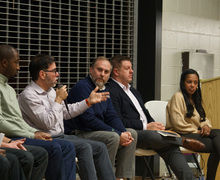Carnegie Mellon apologizes to students after mistakenly sending acceptance letters
Illustration by Juliana Meddick | Contributing Illustrator
Hundreds of students were overjoyed last Monday morning when they received an email saying they were accepted to Carnegie Mellon University’s prestigious graduate computer science program.
But the excitement was short lived when, only one day later, they received notice that their acceptance letter was sent by mistake.
An error in the Carnegie Mellon system that is responsible for generating acceptance letters caused the accidental release of acceptance letters to roughly 800 rejected students on Feb. 16, Ken Walters, executive director of media relations at CMU and spokesman for the university, said in a statement.
“We are currently reviewing our notification process to help ensure this does not happen in the future,” the statement said.
The mistake of accidentally sending the letters occurred at the graduate level, and the applicants were applying to the Master of Science in computer science program at the school, according to the statement.
“We understand the disappointment created by this mistake, and deeply apologize to the applicants for this miscommunication,” the statement said. The day after the release of the mistaken acceptance emails were released, the school sent a follow-up email apologizing for the accidental emails sent to rejected students.
This particular instance of accidentally sending acceptance letters to the wrong applicants is rare because it occurred at a graduate level while similar mistakes have happened slightly more often on the undergraduate level, said Mike Reilly, executive director of the American Association of Collegiate Registrars and Admission Officers, which is one of the oldest higher education groups in the country.
The graduate program in computer science at Carnegie Mellon is among the best in the nation, and it is very prestigious and selective, according to US News and World Report.
There are two strategies that colleges take in accepting students. While some schools accept students on a rolling basis, other schools partake in the pool system where they wait to receive all applications before they select those to accept, Reilly said.
Schools that opt to use the method of pooling applicants run a higher risk of sending the acceptance emails to the wrong email list, especially in the age of technology when mass emails can be sent to the entirety of applicants at one time, Reilly said.
Over the past few years, there have been a few similar scenarios that have happened on a larger scale at the undergraduate level at schools such as Johns Hopkins University and the University of California at San Diego, Reilly said.
Things of this nature are not typically seen at a graduate level because admissions to selective, smaller programs such this are typically handled by the departments that potential students are applying for rather than and admissions office, Reilly said.
Reilly said that one way to prevent the mistake of sending the wrong type of email to students or prevent email list mergers would be to sample some names or spot check files from each list to avoid error before sending the mass email out to an entire sending list.
Published on February 26, 2015 at 12:01 am
Contact Erin: eemcdona@syr.edu





